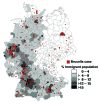Changing epidemiology of human brucellosis, Germany, 1962-2005
- PMID: 18258041
- PMCID: PMC2876757
- DOI: 10.3201/eid1312.070527
Changing epidemiology of human brucellosis, Germany, 1962-2005
Abstract
Trends in the epidemiology of human brucellosis in Germany were investigated by analyzing national surveillance data (1962-2005) complemented by a questionnaire-based survey (1995-2000). After a steady decrease in brucellosis incidence from 1962 to the 1980s, a persistent number of cases has been reported in recent years, with the highest incidence in Turkish immigrants (0.3/100,000 Turks vs. 0.01/100,000 in the German population; incidence rate ratio 29). Among cases with reported exposure risks, 59% were related to the consumption of unpasteurized cheese from brucellosis-endemic countries. The mean diagnostic delay was 2.5 months. Case fatality rates increased from 0.4% (1978-1981) to a maximum of 6.5% (1998-2001). The epidemiology of brucellosis in Germany has evolved from an endemic occupational disease among the German population into a travel-associated foodborne zoonosis, primarily affecting Turkish immigrants. Prolonged diagnostic delays and high case fatality call for targeted public health measures.
Figures





References
-
- von Knorre G. Erfahrungen beim Morbus Bang. Ergebnisse aus zwei Reihenuntersuchungen auf Brucella abortus Bang 1960/61 und 1964. Zschr Inn Med. 1965;20:617–22. - PubMed
-
- Weber A. Current knowledge on the epidemiology, clinical course and diagnosis of brucellosis [in German]. Med Welt. 1979;30:849–53. - PubMed
MeSH terms
LinkOut - more resources
Full Text Sources
Miscellaneous
